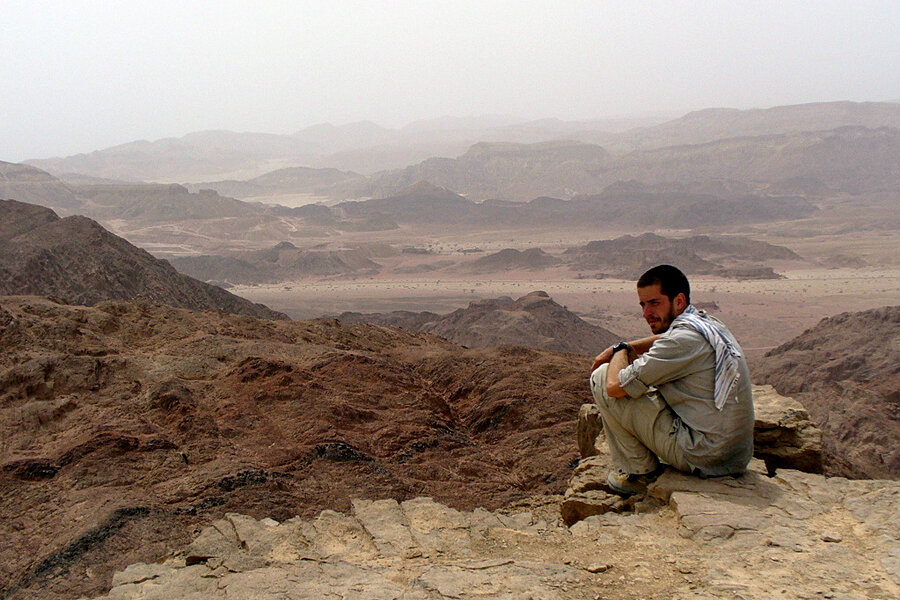Israel has 6,200 miles of marked hiking trails – but hardly a foreigner on them
Loading...
| Jerusalem
It was 1934, and an adventurous group of young Zionist pioneers decided they wanted to hike around the Dead Sea, located in what was then a desolate border region.
So the youths, against the orders of their commanders in the pre-state Haganah paramilitary organization, loaded nine guns and crossed clandestinely into Transjordan. With no good maps, they hit impassible gorges on the Jordanian side of the sea and ran out of water.
After robbing Bedouins at gunpoint for their water, the youths scaled the cliffs down to the salty sea and floated around the huge canyons, eventually completing the full circuit.
From dangerous adventures like these to pleasant field trips to rigorous outings that doubled as military reconnaissance, young Jews developed an intimate knowledge with the land that not only deepened their Zionist goals of statehood but also fulfilled them. They helped Israel win its war of independence against Palestinians and their Arab allies in 1948-49, and went on to develop the 7th-largest hiking network in the world relative to country size.
“Because hiking is something that crosses such a big sector of society, this is not a minor part of Israeli history…. it cuts to the heart of the Israeli experience to the land,” says Shay Rabineau of Brandeis University in Waltham, Mass., who wrote his dissertation on the subject and is working on a book about it. “And in a country where land is so contested, the nature of the Israeli relationship with it is important to know about.”
The very first trail, on the shores of the Dead Sea north of Ein Gedi, was approved on the eve of partition – when Arabs were slated to get that very land – with Palmach commander Yitzhak Rabin helping to secure funding and personnel for establishing the trail. (Editor's note: The original version misstated the location of the trail and the precise role of Rabin.)
Hillel Birger, a Polish-born engineer who grew up hiking with a Zionist youth organization in eastern Europe, and Yossi Feldman, who earned the nickname Yossi the Arab for his Bedouin-like ability to move quickly through the desert, then went on to create a unified system of marking and mapping for the entire country – something that few if any other nations have. Many of the early figures, like Feldman, spoke Arabic and learned their tradecraft from Bedouin, but as political tensions heightened in later years there were clashes between Jewish hikers and local Arabs.
Today, the ideological undertones may not be as strong, but many schools still take annual hikes, and families often celebrate holidays by heading off down a marked trail with kids in tow.
Dr. Rabineau’s own curiosity about Israel’s trails was piqued seven years ago when he hiked the Israel National Trail, which starts near the Lebanon border and ends at the Red Sea. Though it was ranked one of the top-20 “epic hikes” in the world by National Geographic last year, very few foreigners have walked it – or any of the other 10,000 kilometers (6,200 miles) of hiking trails in Israel, which are not only marked but complemented by 20 highly detailed topographical maps.
Part of the reason is that the topographical maps are only available in Hebrew, and there are few English-language resources with the notable exception of the Jesus Trail in the Galilee, whose guidebook and maps have brought thousands of foreigners over the past few years. In addition, many trails are difficult to access by public transportation, limiting access for carless travelers.
Another factor may be that unlike Switzerland or Nepal, some of Israel’s trails pass through rather mundane scenery – the flat desert around the southern city of Beersheva, for example – though others lead through spectacular canyons or lush fields carpeted in spring wildflowers. For Rabineau, that just drives home the larger purpose behind Israel’s trail network.
“To me, the fact that they did all this reflects a passion for the land, a desire for the land that goes way beyond just wanting to see the sites, or encounter nature,” he says. “It has to do with the idea that you’re developing a relationship with the land.”








